| Author |
Message |
|
Nick Winley
|
 Posted: Fri 27 Jul, 2007 12:56 am Post subject: Seax question Posted: Fri 27 Jul, 2007 12:56 am Post subject: Seax question |
 |
|
Hi there,
As usual I'm posting a picture of something half finished. I'm quite proud of it as it's the first blade I've fully shaped on the anvil (apart from the fuller which I ground in later). As you can see it developed somewhat of a curve in the process and my question is this: Have I broken a cardinal rule for seax blades? I can't find a single picture of a Seax with anything other than a dead straight back.
I guess I'm hoping someone will chime in with a "don't be so foolish, many seaxes had curved backs. Here's a link... blah blah blah".
I just had another thought; if I had beaten in the fuller, would that have offset the curvature caused by the making of the bevel?
Out of interest, this blade started out as the other half of the leaf spring that went into this blade: http://www.myArmoury.com/talk/viewtopic.php?t=10227
Anyway thanks for your thoughts.
Nick.
 Attachment: 59.65 KB Attachment: 59.65 KB
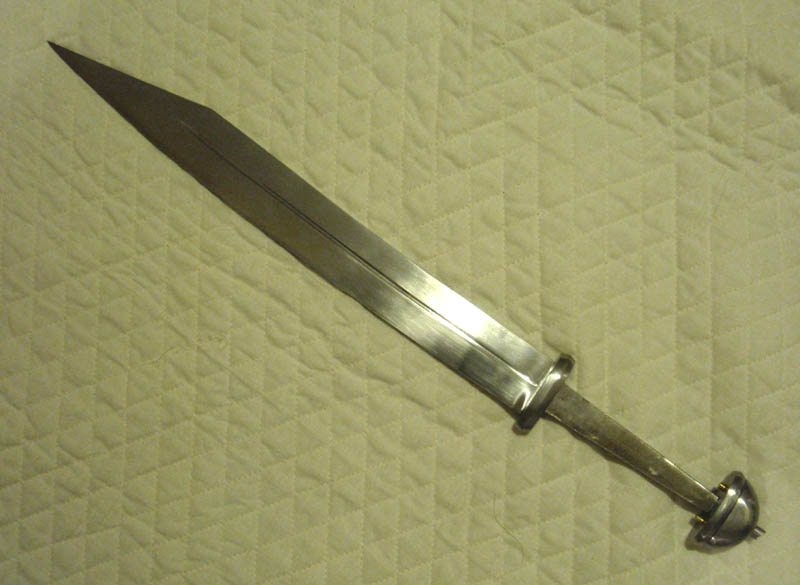
"The Riddle of Steel. Yes! You know what it is, don't you boy."
Last edited by Nick Winley on Fri 27 Jul, 2007 6:13 am; edited 1 time in total
|
|
  |
 |
|
David D
|
 Posted: Fri 27 Jul, 2007 1:34 am Post subject: Posted: Fri 27 Jul, 2007 1:34 am Post subject: |
 |
|
Yeah, forging a seax blade and trying to keep it strait while still getting a nice beveled edge is a real challenge. I honestly think you did a pretty good job!
I donít think you broke any real "SEAX GUIDELINE RULES" that still perfectly fits into the category in my opinion.
I imagine that you forged it from flat stock which meant you were just forging on the cutting edge. Which is what I do as well. But doing it that method makes it a challenge to keep strait.
I am thinking a better for forging a seax blade is actually starting from round stock and hammering it down to shape from there. a lot more work, but you would have a lot more control over the finished shape. At least thatís what I am going to try in the future.
But as for that, I think it looks great, a little curve in a seax never hurt anyone..... Except maybe the Vikings enemies......
great work!!
|
|
 |
 |
|
Ken Nelson
|
 Posted: Fri 27 Jul, 2007 6:45 am Post subject: Posted: Fri 27 Jul, 2007 6:45 am Post subject: |
 |
|
Nice job so far, Hope to see it finished.
Forging a single edged blade and keeping it straight can be a challenge. because you are forging more on the edge than the spine, it will want to curve. Switching to round stock won't help, you are still forging more on the edge.
Some of the tricks I have learned...
Use a coal/coke/charcoal forge, not a gas forge, I know that this sounds odd, but when dealing with larger blades, the coal forge allows you to heat a smaller area. you can only hammer so much before the steel cools down, heating a larger section won't give you more time, and it will give the blade a much larger area to bend and warp.
start at the tip and work your way down the blade once. sounds obvious, but I have seen people go up and down a blade several times, and then take out the curvature with a grinder.
When I take the blade out of the fire, I first place it on the anvil edge up, raise the tang end, and give it a good whack or two to pre-bend it. Then as I hammer out the bevel, it will straighten itself. This takes a little practice to see how much bend to put in. and get the blade straight before putting it back in the fire. if it has cooled too much, then heat it a bit less than usual. and get it straight. anything you leave in will only get worse as you work your way down.
and finally, get yourself a Thwak'em stick (yes, I got the term from Battlelords of the 23rd Century) A thwak'em stick is a baseball bat, a wooden mallet, or just a nice sized log. if you need to hammer on the edge of the blade to straighten it, the thwak'em stick is less likely to flatten out the edge you so recently hammered in.
And as for the fuller? a thin fuller in the center of the blade should not curve it one way or the other, if you were to hammer it in near the spine, it would curve the blade downward. generally a wider fuller will curve the blade more than a narrow one.
Good luck
Ken
"Live and learn, or you don't live long" L. Long
|
|
   |
 |
Jean Thibodeau

|
 Posted: Fri 27 Jul, 2007 1:17 pm Post subject: Posted: Fri 27 Jul, 2007 1:17 pm Post subject: |
 |
|
Looks great to me.  The curve seem very subtle in the pic to me and would a period smith even be bothered by the fact that it's not ruler strait ? We do see a lot of asymmetry in Medieval swords that would bother us like lumpy pommels and uneven length on each side crossguards. The curve seem very subtle in the pic to me and would a period smith even be bothered by the fact that it's not ruler strait ? We do see a lot of asymmetry in Medieval swords that would bother us like lumpy pommels and uneven length on each side crossguards.
With seax I'm not sure if curved ones where even made: Seriously curved I mean ! But just in heat treating a blade might take a small curve that might not even be noticed ?
Looking forward to seeing it finished.  
You can easily give up your freedom. You have to fight hard to get it back!
|
|
  |
 |
|
Nick Winley
|
 Posted: Fri 27 Jul, 2007 9:56 pm Post subject: Posted: Fri 27 Jul, 2007 9:56 pm Post subject: |
 |
|
Thanks for the comments and advice people.
Ken, just for the record I do use a charcoal forge and it's probably the reason the curve is not more severe.
I'm now trying to decide whether or not to make the blade more ornate or just stop while I'm ahead. Perhaps I'll try some copper inlay on a test piece first and see how I go.
Cheers,
Nick.
"The Riddle of Steel. Yes! You know what it is, don't you boy."
|
|
  |
 |
|
Justin King
Industry Professional
|
 Posted: Sat 28 Jul, 2007 6:31 am Post subject: Posted: Sat 28 Jul, 2007 6:31 am Post subject: |
 |
|
Single edged blades tend to recurve when they are oil quenched so some of the saber-curve that comes from forging the edge bevels can be offset during heat treating. I try to get the bevels roughed in first, then curve the blade forward enough that the final edge forging will bring it back to a vey slight saber curve, then let the quench take the rest out (hopefully).
Another very nice bit of work, by the way.
|
|
  |
 |
Bruno Giordan

|
 Posted: Sun 29 Jul, 2007 2:00 am Post subject: Posted: Sun 29 Jul, 2007 2:00 am Post subject: |
 |
|
Well, langbarten (lombard) seaxes had a smooth back curve.
But this population originated in Pannonia (Hungary) , even if coming in ancient times from Scandinavia, then moved from Pannonia to Italy, so it is not of interest for the descendant of the anglo-saxons.
Their belt fittings were surprisingly similar to the viking ones, though, even when they settled in Italy, which was much later than they had left Scandinavia.
They made large use of seaxes also.
An important langbarten sax is in Brescia's Museo Marzoli, Peter Johnson made a super replica that should be documented somewhere on the Albion website.
The original carries a runic futharc inscription that could be of a certain importance if somebody bothered to study it.
|
|
  |
 |
|
Audun Refsahl
Location: Norway Joined: 15 Feb 2006
Posts: 82
|
 Posted: Sun 29 Jul, 2007 1:46 pm Post subject: Posted: Sun 29 Jul, 2007 1:46 pm Post subject: |
 |
|
are you trying to recreate or copy any specific place and period type seax?
to the degree you could call the norwegian vikings large fighting knife a seax there are plenty of curved examples, in fact among the thousands of viking weapons that has been dug up in norway, only two straight edged broken back seaxes has been found from viking period, all other fighting knifes has had curved edges and more curved than broken backs, with a profile more like a dagger or something, single edged ofcourse... I believe the trend is much the same in sweden, and quite varied in denmark... in the transition period however, they seem to have been quite straight... I think you could allow yourself some flexibility...
just bacon...
|
|
   |
 |
|
Nick Winley
|
 Posted: Sun 29 Jul, 2007 2:35 pm Post subject: Posted: Sun 29 Jul, 2007 2:35 pm Post subject: |
 |
|
Thanks for the info guys.
Bruno, do you have any pictures of the seax in the Museo Marzoli?
Audun, I'm not trying to be particularly historically accurate, just looking for a broken back kind of feel. I'm not even sure the hilt I'm going for is appropriate for this type of blade.
Cheers,
Nick.
"The Riddle of Steel. Yes! You know what it is, don't you boy."
|
|
  |
 |
Jean Thibodeau

|
 Posted: Sun 29 Jul, 2007 9:26 pm Post subject: Posted: Sun 29 Jul, 2007 9:26 pm Post subject: |
 |
|
| Nick Winley wrote: | Thanks for the info guys.
Bruno, do you have any pictures of the seax in the Museo Marzoli?
Audun, I'm not trying to be particularly historically accurate, just looking for a broken back kind of feel. I'm not even sure the hilt I'm going for is appropriate for this type of blade.
Cheers,
Nick. |
Accurate to history or not I really like the way it looks. 
You can easily give up your freedom. You have to fight hard to get it back!
|
|
  |
 |
Bruno Giordan

|
 Posted: Mon 30 Jul, 2007 11:51 am Post subject: Posted: Mon 30 Jul, 2007 11:51 am Post subject: |
 |
|
| Nick Winley wrote: | Thanks for the info guys.
Bruno, do you have any pictures of the seax in the Museo Marzoli?
Audun, I'm not trying to be particularly historically accurate, just looking for a broken back kind of feel. I'm not even sure the hilt I'm going for is appropriate for this type of blade.
Cheers,
Nick. |
Here they are: the langsax (upper image) and an average sax, the most commonly retrieved type.
http://bghomofaber.googlepages.com/seaxes
Pics are heavy, page is makeshift, sorry.
Other swords left for comparison, the langsax is photographed nearby the famous Brescian Spadona so well reconstructed by Peter Johnson
|
|
  |
 |
|
Nick Winley
|
 Posted: Fri 03 Aug, 2007 12:20 am Post subject: Posted: Fri 03 Aug, 2007 12:20 am Post subject: |
 |
|
Ok as promised I had a go at some copper inlay on the blade. I soon learnt is how quickly trying something like this can make you very sad about the damage you've done to your precious blade. However, persistence pays off and I think I ended up with some moderate success.
The copper (from electrical wire) was beaten into a chiseled groove with the help of a propane torch. As you can see the blade has not come through the ordeal entirely unscathed.
There is a good tutorial for doing this sort of thing here: http://www.thecarvingpath.net/forum/index.php...=7664& Though it should be noted it refers to working on mild steel.
I also learned that photographing copper inlay is harder than you'd think. None of the wider shots worked at all. The photo below has had the contrast turned right up, consequently a whole parade of sins have become visible.
The only question now is what will happen to it when it's heat treated?...
 Attachment: 61.27 KB Attachment: 61.27 KB
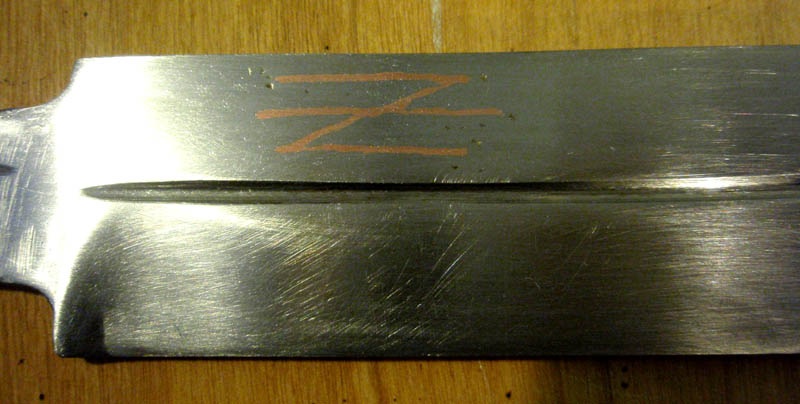
"The Riddle of Steel. Yes! You know what it is, don't you boy."
|
|
  |
 |
|
Nick Winley
|
 Posted: Fri 07 Sep, 2007 1:50 am Post subject: Posted: Fri 07 Sep, 2007 1:50 am Post subject: |
 |
|
I finally have this finished.
The blade is, as mentioned above, from leaf spring. The grip is a sandwich of Tasmanian Oak wrapped with Dear hide.
Total length: 50.4cm (19 7/8")
Blade length: 36.4cm (14 5/16")
Grip length: 10.6cm (4 3/16")
Blade width at base: 3.5cm (1 3/8")
Blade thickness at base: 5mm with very little taper up to the bend.
Weight 640g (22.5 oz)
Cheers,
Nick.
 Attachment: 23.01 KB Attachment: 23.01 KB
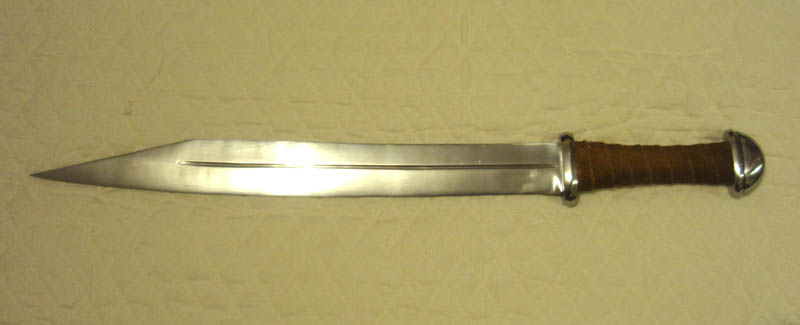
 Attachment: 23.73 KB Attachment: 23.73 KB

 Attachment: 38.41 KB Attachment: 38.41 KB
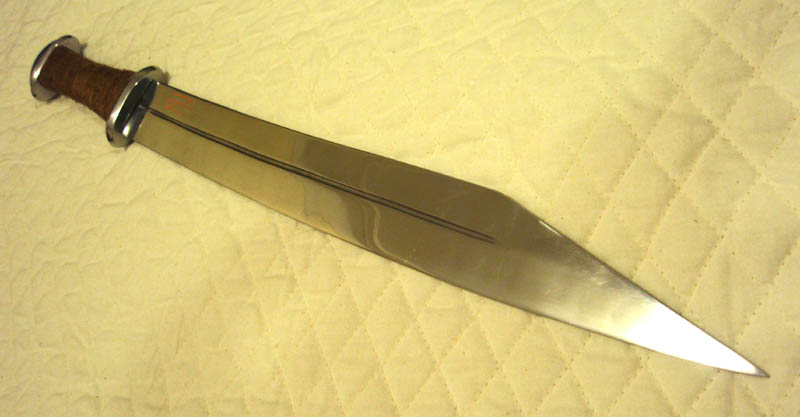
 Attachment: 43.86 KB Attachment: 43.86 KB
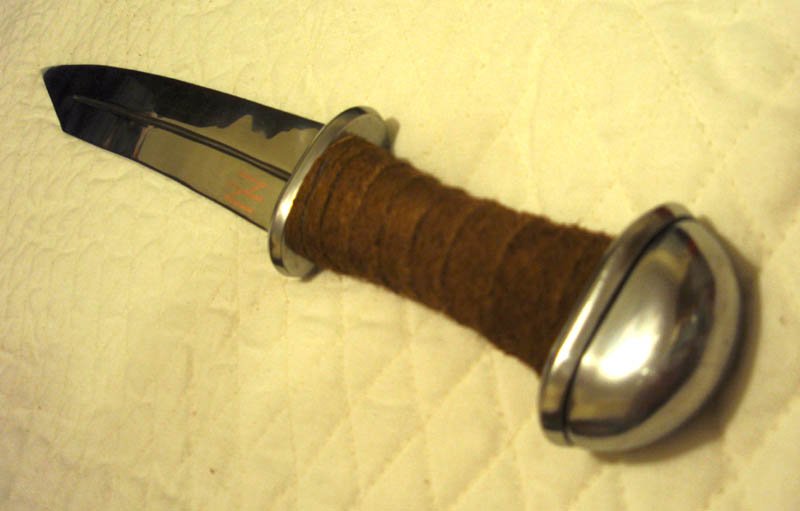
 Attachment: 36.01 KB Attachment: 36.01 KB
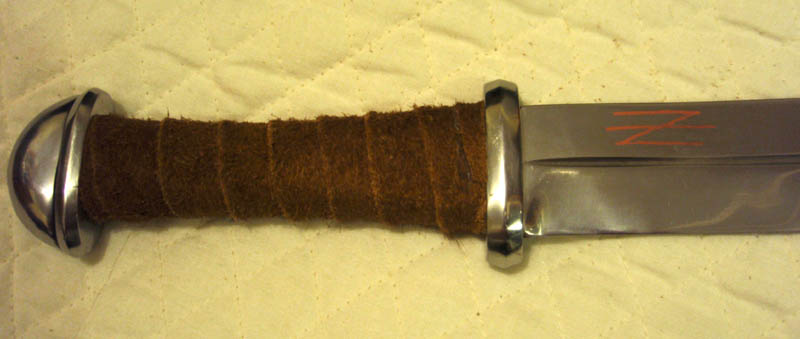
"The Riddle of Steel. Yes! You know what it is, don't you boy."
|
|
  |
 |
Bruno Giordan

|
 Posted: Fri 07 Sep, 2007 11:53 am Post subject: Posted: Fri 07 Sep, 2007 11:53 am Post subject: |
 |
|
it's a nice blade, especially the pommel.
the curve might have been corrected in the forge, it happens to me so often to turn naturally born kukris into seaxes ...
I have redressed worst cases of serpentine behavior.
Also you might hav ground away the curve before heat treating, warping is minimal.
Sorry for not having said it before but your first pic didn't show the real problem, which isn't really big anyway.
Last edited by Bruno Giordan on Sat 08 Sep, 2007 12:48 am; edited 1 time in total
|
|
  |
 |
|
Nick Winley
|
 Posted: Fri 07 Sep, 2007 4:50 pm Post subject: Posted: Fri 07 Sep, 2007 4:50 pm Post subject: |
 |
|
Thanks Bruno,
Not to worry, to tell the truth, having had it sitting around for a couple of months I've come to love it just as it is - like an ugly child 
"The Riddle of Steel. Yes! You know what it is, don't you boy."
|
|
  |
 |
|
Harold R.
|
 Posted: Fri 07 Sep, 2007 7:30 pm Post subject: Posted: Fri 07 Sep, 2007 7:30 pm Post subject: |
 |
|
Well it is certainly better than anything I could have made. I wouldn't complain if I found your seax hanging on my side.
If the curve bothers you, give it a female name.
Girls are supposed to be a little bit curvy...

|
|
   |
 |
Jean Thibodeau

|
 Posted: Fri 07 Sep, 2007 9:29 pm Post subject: Posted: Fri 07 Sep, 2007 9:29 pm Post subject: |
 |
|
| Nick Winley wrote: | Thanks Bruno,
Not to worry, to tell the truth, having had it sitting around for a couple of months I've come to love it just as it is - like an ugly child  |
Very far from an UGLY child: More like one with surprising talent. 
Very nice work and the warping seems like it was minimal to start with and could be left as is or the profile re-ground to get rid of it if it was annoying. A slight negative curve can actually be very good functionally.
I'm fairly sure that in period they wouldn't even have worried about it unless the maker had OCD about strait lines.  
( OCD: Obsessive Compulsive Disorder which in mild cases might mean just straitening crooked picture frames or keeping throw carpets parallel to walls and stuff ).
( EDITED: Re-read the original post and notice that I had interpreted the comments to mean a negative curve on the edge side and it seems that it was a slight curve on the back ).
You can easily give up your freedom. You have to fight hard to get it back!
|
|
  |
 |
|
|

